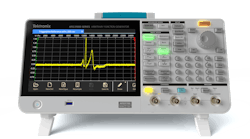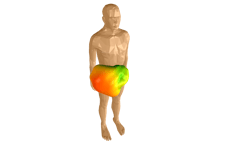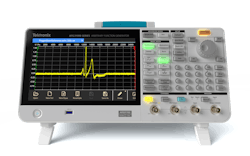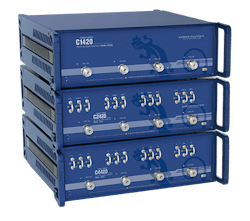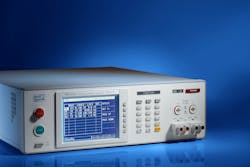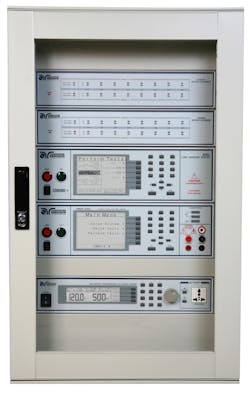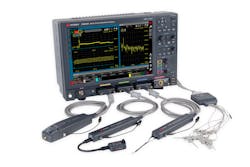Special Report: Medical test challenges extend from simulation to compliance
Wearable, mobile, implantable, and home health devices as well as electronic components, circuit boards, and subassemblies incorporated into medical equipment used in clinical settings all present significant test challenges. Effective test strategies extend from design and simulation to test-system integration and regulatory compliance test. Products to meet the challenges range from simulation and design-for-test tools to instruments and automated systems.
Simulation
According to Kirthi K. Devleker, global medical devices and biopharma industry manager at MathWorks, the market for medical electronics is large and growing. “According to a Grand View Research report,1 the global medical electronics market is estimated to be around $186 billion by 2024,” he said. “The rapid growth of the medical electronics market is mainly due to the rising incidence of lifestyle or chronic diseases and the trend of miniaturization in biomedical sensors.”
These ubiquitous sensors, Devleker said, generate vast amounts of physiological data. “To unlock the insights hidden in the data, many organizations are turning to artificial intelligence and model-based design solutions to help in building and testing the next generation of medical devices across a broad spectrum of applications ranging from home monitoring products such as wheeze monitors to very complex medical imaging systems (like MRI machines) and robotic surgery applications,” he said.
Devleker described the roles several MathWorks offerings can play in medical applications. “Large research institutes like UT Austin have used advanced signal processing tools like Wavelet Toolbox along with Deep Learning Toolbox to identify patterns in large datasets of brain signals for the purposes of converting those into speech signals,” he said. “And engineering organizations like ITK Engineering have used Simulink, Stateflow, and Embedded Coder products for performing overall modeling, verification, and validation testing of dental drills and also for ensuring compliance with regulatory agencies.”
Devleker added that modern medical devices, especially Class 3 devices (for example, stent implants), are increasingly complex, and a large part of the complexity lies in the software that controls the device. “One of the biggest challenges in testing such devices is to verify the ‘correctness’ of the software code to comply with the strictest standards set for patient safety,” he said. “Typically, the use of standard verification methods falls short as these practices do not scale as the code base becomes large or complex. To overcome such testing challenges, users require tools like Polyspace Bug Finder and Polyspace Code Prover to help formally prove the absence of critical runtime errors related to safety under all possible control and data flows.”
Manohar Raju, senior product specialist, Ansys, said the company offers modeling and simulation tools for use throughout the development cycle. “Simulation saves substantial time and money by cutting down on building and testing,” he said. “Simulation can also be particularly helpful in expediting responses to FDA resubmissions. For example, if a medical device is up for an FDA resubmission due to a manufacturing defect or a process change, simulation tools can be used to meet looming deadlines and respond to FDA inquiries early.”
Dr. Sara Louie, manager, technical support, Ansys, said the company offers multiphysics simulation solutions for designing reliable medical devices before beginning testing cycles to reduce the number of tests. “Advanced 3D physics simulation from Ansys predicts device performance and empowers engineers to solve the biomedical engineering challenges associated with developing robust and reliable products,” she said. “Importantly, advanced simulation from Ansys ensures optimal medical device performance while reducing the recalls and overall development costs that have been associated with delivering the best medical care to patients worldwide.”
Dr. Louie cited as an example insulin pumps, which she described as “…one of the most recall-plagued medical devices.” She continued, “Ansys multiphysics simulation solutions allow engineers to run virtual what-if scenarios to detect potential failure modes and analyze complex interactions among an insulin-pump system’s various components before the first prototype is built and tested.” She added, “Ansys simulation solutions have been shown to help engineers design these devices to have more efficient wireless communications systems, increased mechanical reliability, and error-free embedded control software. By using Ansys as a virtual prototyping platform, engineers can identify design and integration issues early in the R&D process, which greatly improves product performance and safety while reducing cost and time-to-market.”
Dr. Louie pointed out that some things can’t be visualized—like 3D electric field patterns or PCB current flows. “The only way to see everything that’s physically happening is with simulation,” she said. “In addition, simulating what-if scenarios allows the user to see how the physics respond to changes in design to produce a better or worse end-result.”
She said that through collaboration with the FDA and medical-device industry, Ansys has developed an extensive library of human body models. “The models represent various body types that are used in virtual clinical trials to predict safety and efficacy,” she said. “For example, consider the computational coil model for MRI compliance of implanted devices. In the case of MRI multiphysics, we’re looking at currents induced on implanted devices which generate heat in the body. Tissues can only withstand so much heat. Herein lies the importance of simulation. There is no way for someone to reliably measure temperatures in full 3D. Only simulation can show what the highest temperature value of the implanted device is during the MRI and where it is located. In this way, Ansys simulation tools can identify worse-case scenarios to decrease the number of test cases for submission to FDA.
Design and integration
Javier Olea, area sales manager at Averna, said the company offers custom test solutions for medical device applications across the product lifecycle. Some applications the company has served include ECG, NIBP, Sp02, pH, and blood-glucose monitors for both hospitals and portable/ambulatory uses; implanted devices like pacemakers, defibrillators, and hearing aids; ventilators; cable and lead-wire systems (ECG, catheters, device cables); surgical devices; and endoscopes.
“Each system is custom-designed to best serve the appropriate application,” said Olea. He said that as a National Instruments Platinum Alliance Partner, Averna frequently leverages NI hardware as well as TestStand and LabVIEW as well as Averna’s own RF expertise and machine-vision experience. “We also offer off-the-shelf data-management tools to maximize production-floor results,” he said.
For its part, National Instruments offers hardware, software, and services for developing, deploying, and maintaining automated test systems for a variety of medical devices, from high-end surgical systems to high-volume implantable devices, according to Vineet Aggarwal, offering manager, and Graham Green, solutions marketer. “NI offers instrumentation, test-system infrastructure, and software to assist with test development, execution, and system management,” they said. “Some examples of instrumentation for medical-device test and measurement applications are PC-based multifunction DAQ devices, PXI modular instruments, and C Series I/O for portable measurements with built-in signal conditioning.” NI products have been applied to applications such as the development of a pacemaker test system.2
They described NI’s offerings as software-defined systems, with interfaces for LabVIEW, C, C#, Python, and other development environments. “NI also has additional software tools like TestStand for automating test steps and sequences, Diadem for data mining and analysis, and Requirements Gateway for design requirements tracking and traceability,” they said. “As enterprise/cloud connectivity grows and becomes a standard part of test systems, NI SystemLink enterprise software is used to manage data and optimize test station utilization.” They added that NI offers services—both directly and indirectly through partners—to assist with integrating and using these tools or to outsource entire parts of the test process. They also said most medical devices require some form of electrical functional test in manufacturing.3
According to Janet Ooi, IoT industry solutions lead at Keysight Technologies, Keysight’s solutions address medical electronics from the component level to devices and systems—including medical components such as MEMS microphones for hearing aids and RF coils for MRI systems; medical devices such as implantable heart pacemakers, continuous glucose monitoring (CGM) devices, and fitness trackers; and medical systems such as MRI, ultrasound, and other diagnostic imaging systems.
“Apart from test solutions, Keysight offers cybersecurity solutions for medical infrastructure and institutions.” She said. “This is critical to ensure a reliable healthcare ecosystem as advances in IoT create vulnerabilities.”4
Ooi cited several solutions the company offers, including a portfolio of instruments for wireless-communications, RF/microwave, high-speed digital, precision-power, photonics, and general-purpose testing. “Keysight also offers full network test and visibility test solutions that cover the physical layer through the application layer,” she added.
She also said Keysight offers board-test solutions for electronics manufacturers to tackle various in-circuit and functional test challenges as well as the PathWave software platform to facilitate customers’ new product development workflow from circuit design to real-world simulation and validation test, including the capability to interoperate with test equipment.
for designing the low-noise, isolated power supplies common in the medical market. “Meanwhile, instruments like the Keithley 6517B electrometer are used for qualifying high-R insulators and validating electrical leakage from medical devices,” he said. “For special applications, the 6517B has long been trusted in measuring charge collection, ensuring that a device doesn't collect dangerous amounts of static electricity in medical applications.”
Semiconductor EDA
Mentor, a Siemens Business, addresses medical electronics test with semiconductor EDA tools. “Mentor’s Tessent portfolio, with its Tessent Safety Ecosystem, can provide a full hardware test solution which includes both extremely high-quality manufacturing test along with a fully functional safety solution,” said Lee Harrison, Tessent automotive IC test solutions manager. “Functional Safety is currently a hot topic in the automotive market, but also for medical electronics or any safety-critical application.” The goal is to ensure a device is not just defect free at manufacture but behaves as expected during functional operation, Harrison said. If a defect—either static or transient—does occur during operation, the device must be capable of monitoring and detecting this defect and taking the appropriate corrective action, he added, explaining that such action may be deploying some redundancy to correct the issue or raising an alarm in a timely manner.
Harrison described Mentor’s Tessent platform as a suite of software EDA tools, which can be categorized into different areas. “Initially the software tools can be used to generate hardware IP that is inserted into the design,” he said. “This IP can be used to support either manufacturing or test applications, so technologies like ATPG compression, scan, memory BIST, logic BIST, boundary scan, or functional safety IP can be added, as can technologies such as parity, logic duplication, ECC, and lockstep.”
Electrical safety
Chroma Systems Solutions provides test instruments and automated test systems used for testing medical-device electrical safety in compliance with the IEC 60601-1 3rd addition standard, according to Dan Carter, EST marketing product manager. “Chroma 19032 and 19032-P electrical safety analyzers are designed with medical device testing in mind,” he said explaining that they combine hipot, ground-bond, and insulation-resistance test and also perform leakage-current testing when paired with a leakage-current scanning card and one of Chroma’s regulated AC power sources.
“Our basic hipot testers, like the 19052, can perform dielectric withstand test and may be paired with our CaptivATE software for instrument control and data capturing capabilities,” Carter added. “The 19572 ground-bond tester will perform a ground-bond test for grounded medical devices in accordance with the standard.”
Carter commented that CaptivATE Enhanced is specifically designed for medical device testing. “From IQOQ validation, control over test files, traceability, and automatically exported test reports, it has everything covered to give medical device manufacturer’s peace of mind,” he said, adding that CaptivATE Enhanced software walks our customers through IQOQ validation, stores serial numbers and calibration due dates of equipment electronically, and automatically exports test data and reports to a PC or SQL server database.
Carter also commented on automated test. “What sets Chroma apart is our expertise in building automated test systems for the medical device industry to simplify the complex requirements of 60601-1,” he said. He described the company’s Sentinel systems as completely customizable, adding that they provide IQOQ protocol documentation. “We take the guesswork out of medical device testing by building Sentinels for the most complicated test requirements like MOAP (Mains on Applied Part),” he said, adding that all Sentinel systems come with CaptivATE software, which gives customers control over the equipment and data so they can ensure compliance, quality, and traceability.
Also addressing electrical safety test is Ikonix. According to Nicholas Piotrowski, product manager at Ikonix USA, “The majority of our test applications for medical revolve around the base IEC 60601-1 standard for safety and compliance testing of electromedical devices,” including ECG, electrosurgical generators, pulse oximeters, and ultrasound equipment. Ikonix equipment can perform ground bond (ground continuity of the ground conductor), AC and DC hipot (dielectric withstand testing), IR (insulation resistance), and functional-run testing as well as LCT (leakage current testing) for all electromedical devices, he said, adding that LCT is commonly used in laboratory and medical device testing.
Specific Ikonix EST products include the OMNIA II 8204/54 Series in combination with the 620L LineCHEK II leakage tester, the SC6540 scanning matrix, and Autoware 3 software for test and instrument control, test creation, and data collection. (See the special report on modular instruments in this issue for more on these products.)
“Our instruments along with our test software allow us to offer a complete automated electrical compliance test solution for our customers,” Piotrowski said. “They are used anywhere from NRTL compliance labs all the way up to automated medical-device-testing production floors.”
USB VNA
In some cases, the electronics test instrument can become part of a medical system, as described by Brian Walker, senior RF design engineer at Copper Mountain Technologies. “Our 1-Port vector network analyzers have been used to measure the dielectric constant of tissue in order to identify tissue type for precision or robotic surgical excision,” he said. “The measurement of tissue types is literally cutting-edge technology. Our VNAs are small and portable enough to be integrated directly into larger medical and surgical systems.”
Walker continued, “Our 2-port Compact VNAs have been used for measuring the resonance of ‘Body’ and ‘Head’ coils for MRI imaging of human patients.” He added that 4-port Cobalt VNAs have been used to measure differential cables for high-speed digital data transfer in a dental imaging system.
There is one challenge, though, especially with regard to applications such as tissue measurement. “Users of our equipment in unusual medical applications may not have a great understanding of RF principles,” Walker said. “Our support staff is ready to understand these unique applications and supply useful guidance to our VNA users.”
Product life cycle
Various design, simulation, and test products serve various aspects of the end-product life cycle. For example, “Our tools have traditionally been focused on production test, which is one of the earlier parts of a product lifecycle,” said Harrison at Mentor. “However, with our BIST technologies for functional safety, the scope of our technology offerings now extends throughout the life cycle of the product.”
She cited an MRI antenna system as an example. “Our customer uses the PathWave platform for antenna design and electromagnetic simulation. They then have the Keysight network analyzer for parametric test and validation at prototyping and manufacturing. For MRI system deployment, our portable FieldFox microwave analyzers are used by many site engineers to inspect interference signals and for calibration purposes.”
Raju said that Ansys simulation tools are used at the earliest stages of the product development cycle. “Through virtual prototyping and simulation, engineers study the performance of their designs, conduct virtual what-if experiments, isolate design flaws, and resolve them before building the first physical prototype,” he said. “Unlike the build-and-test approach, Ansys multiphysics simulation allows engineers to quickly and cost-effectively iterate through design variations, accelerating the path from concept to high-fidelity designs.”
“Any medical-device product, at a high level, goes through the following four stages (from a product lifecycle perspective): concept, design, verification and validation, and regulatory compliance,” said Devleker at MathWorks. “Throughout these four stages, model-based design with MATLAB and Simulink provides a consistent approach for product development from developing and simulating algorithms and models to quickly deploying them in software and hardware implementations with the help of automatic code-generation capabilities.” He added that model-based design is particularly useful when physical prototypes do not exist; it offers a unified approach that spans modeling, simulation, rapid prototyping, implementation, and verification— helping automatically propagate any changes in top-level models all the way to verification and validation workflows.
According to Aggarwal and Green, NI’s software-centric platform is used across all stages of a product’s lifecycle. “In early-stage research and prototyping, proving out initial design ideas and reducing risk requires flexible test systems that can quickly adapt and iterate with each prototype,” they said. “Developing automated V&V systems also requires customization to achieve the best test coverage, and a subset of the V&V plan can ultimately be reused for production line testers as well.”
Olea at Averna commented, “We have delivered countless projects starting from the R&D stage through to NPI and support and repair. Projects have included everything from V&V to high-speed defect detection and sorting at any point in the product lifecycle.”
As for electrical safety test, Carter at Chroma said, “Our products are used throughout the product lifecycle. We sell Sentinel systems to R&D and production alike but can customize the solution based on where the test is being performed.” And Piotrowski at Ikonix commented about his company’s products, “They are used at multiple points in the development cycle. They’re used for R&D and prototyping to test product design. They’re also used in full production to ensure the manufacturing process has not compromised device safety or quality.”
Odhner commented that the Keithley and Tektronix general-purpose instruments are largely used in the research and design phases. However, he added, “Some of our products are used primarily in production testing, like our 2300 Series battery simulators and 3706A switching system/DMM, both of which are commonly used in the medical field for wearable production testing.”
Trend toward AI, IoT
Common trends in the medical electronics field include the use of artificial intelligence and machine learning and the adoption of the IoT. “More and more medical devices need to communicate with the user through apps on smartphones, tablets, watches, etc.” said Olea at Averna. “New functional testers are being designed to accommodate medical-device companies integrating mobile accessibility into their products.”
Commented Piotrowski at Ikonix, “Data is king. All data (testing data, IQOQPQ data) must be kept on record and tracked per the FDA. IoT, as a result, is having a big impact on streamlining data mining and perfecting analytics.”
According to Aggarwal and Green at NI, “The largest trend we’ve seen is the increasing need to test and validate wireless protocols, to help enable more smart, connected medical devices. This could be connectivity testing, with standards like Bluetooth or Wi-Fi, or also cellular standards like 5G NR.” They continued, “In addition, we’re seeing an increase of single-use, temporary, or portable medical monitoring devices, which must be produced in much higher volume than traditional medical electronic devices. This creates the added challenge of developing and maintaining high throughput production lines and test stations that balance test coverage, cost, and throughput.”
“Technology is now more compact, faster, and affordable,” concluded Ooi at Keysight. “It has become an expectation from consumers and healthcare providers that new healthcare devices and tools are intelligent—with multiple sensors connected wirelessly to each other and the internet. The future of healthcare will see a combination of the IoT with artificial intelligence, machine learning, and cloud services. Test strategies will become a lot more complex and will need to include all five C’s of IoT”: connectivity, continuity, compliance, coexistence, and cybersecurity.
REFERENCES
1. Medical Electronics Market Size, Share & Trends Analysis Report By Application (Imaging, Therapeutics, Patient Monitoring, Homecare/Handheld Products), Segment Forecasts, 2018-2024, Grand View Research, September 2016.
2. Park Jong-Dea, Development of a Pacemaker Test System Using LabVIEW, Biomedical Toolkit, and PXI, Case Study, National Instruments.
3. Electrical Functional Test Station, Brochure, National Instruments, 2020.
4. Design and Test Solutions for Medical IoT Devices, Brochure, Keysight Technologies, 2018.
